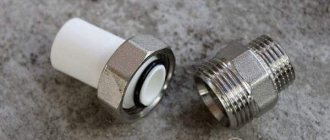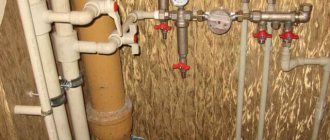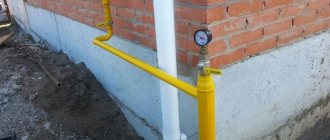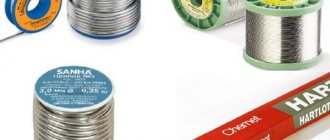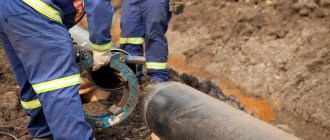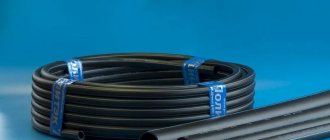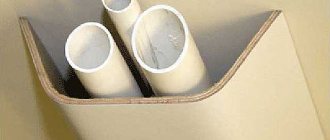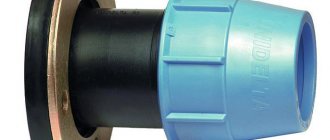Linen
Sealing threaded joints using flax thread is one of the oldest and most proven methods. Linen is sold in any plumbing store and markets.
When purchasing, be sure to pay attention to the following signs:
- elasticity of the thread;
- absence of garbage, unpleasant odor;
- small thickness of strands.
Linen in its pure form begins to quickly rot upon contact with water, with temperature changes, and in heating systems it completely burns out. In addition, the material does not help prevent rusting of metal pipes and fittings, unlike more modern sealants.
To level out these shortcomings, the thread is impregnated with special compounds (pastes). Thickly grated natural red lead is often used. The cheapest option is to make the paste yourself by taking whitewash and adding drying oil until you get a mass like sour cream. It is applied to the linen thread in a thin layer, smeared and dried.
Red lead is more suitable for working with steel pipes: it oxidizes the top layer of iron to an insoluble compound that does not allow oxygen to pass through, working like a bluing process. Stores also sell ready-made flax thread sealant pastes:
- Unipak (soap, chalk, paraffin, water, mineral oil).
- Multipak (paraffin oil with mineral additives).
- Pastum GAS (organic binders, special fillers, additives and anti-corrosion additives).
- Gebatout 2 (white mineral oil, thickener, synthetic polymer, mineral filler).
If the specified means are not at hand, for better sealing of gas connections, you can impregnate the flax with ordinary oil paint or automotive sealants.
The work is done as follows: a strand of flax 2 matches thick is separated from a common skein, wound onto the thread, starting from the far end and ending at the end of the pipe. After this, the flax is coated with paste, the joint is assembled (when twisting, force should be felt).
Sealing thread for gas system
There are three main pipe connection methods used to assemble gas pipelines. The welding connection is durable, but can only be performed by professionals. The flange method does not have a high level of reliability and is rarely used on the crane.
The threaded connection method allows for strength and durability.
Another advantage of the threaded method of assembling a gas pipeline is the receipt of a dismountable connection, which allows repair work to be carried out on the unit without replacing individual structural elements. However, the connection with threaded fittings must be sealed. Read on to find out what gas sealants you can use.
Sealing materials for gas pipes
Requirements for gas sealants
To completely eliminate gas leakage at the connecting points of the gas pipeline system, it is necessary that the winding meet the following requirements:
- resistance to vibrations of varying intensity;
- resistance to sudden changes in temperature and internal pressure;
- protection of the connection from the formation of corrosive deposits;
- ease of installation and dismantling in case of repairs;
- durability and long period of use.
Types of sealants approved for use in gas systems
Gas pipes are sealed:
- linen thread;
- specialized pastes;
- solvent-based sealants;
- FUM tape;
- special threads;
- silicone sealants;
- anaerobic sealants.
Benefits of linen thread
The most popular sealant for gas connections used for household purposes is flax thread.
Linen thread for sealing joints
The advantages of this seal are:
- versatility. The thread can be used not only to connect pipes of the gas supply system, but also for plumbing, heating, and so on;
- low cost. Plumbing flax thread is the cheapest type of sealant for a gas pipe;
- connection reliability.
Negative aspects include:
- complexity of installation. It is recommended to carefully straighten the thread, combine several fibers into one tape and only then tightly screw it onto the threaded fitting;
- possibility of fittings breaking. Linen requires a lot of tightening of the connection to increase the density, which can lead to breakage;
- low resistance to high temperatures.
Giving flax extra strength
Liquid pastes: pros and cons
The main sealant for gas stoves and other equipment not intended for high pressure is a non-hardening paste made from resin, oil and additional substances that give the composition strength.
Sealing pastes
The significant advantages of sealing compounds of this type are:
- ease of application. The threaded connection is coated with sealant by hand or with a brush;
- protection against rust formation;
- ease of installation/removal of fittings.
No sealant is used:
- on high pressure pipes;
- in the presence of a small gap.
Unlike the previous type, solvent-based sealing pastes differ:
- reliable fixation of the fitting;
- resistance to temperatures and operating pressures of different levels;
- ease of application;
- speed of drying. When assembling the connection, the paste is not squeezed out, staining pipes, walls, hands, etc., but remains inside the fitting.
Fast drying sealant for gas pipes
Negative qualities include:
- drying out of the composition, which leads to the need to periodically tighten the fitting;
- impossibility of dismantling without destroying the sealing layer.
Using FUM tape
The most modern sealing material is gas FUM tape.
Gas sealing tape
For the manufacture of sealing material, lightweight fluoroplastic tape is used, which differs:
- resistance to temperatures and pressure;
- chemical resistance;
- Possibility of use in an oxygen environment.
Negative qualities include:
- low level of compaction;
- low vibration resistance;
- the possibility of displacement during installation, which will lead to depressurization of the connection;
- limited use.
How to wind FUM gas tape? The connection is sealed in the following order:
- cleaning the thread surface from dust and dirt;
- degreasing the surface;
- winding the tape clockwise;
- fixing the ends of the tape.
Thread sealing with FUM tape
How to wind the seal correctly, watch the video.
Sealing with special threads
Popular among specialists is a sealant for gas boilers, pipes and other equipment, made in the form of a thread. The nylon cord, which is the basis of the seal, is additionally impregnated with various compounds that give the connection additional strength.
The most popular representatives of this group are Loktain and Tangit Unilok threads.
Sealing thread for gas system
The threads are different:
- ease of use;
- low cost;
- seal strength;
- resistance to different temperature conditions.
Silicone and anaerobic sealants
To seal connections in the gas supply system, you can additionally use silicone or anaerobic sealants.
These compositions differ:
- simplicity of sealing: the composition is applied to the thread and the fitting is installed;
- connection strength;
- Possibility of use in different environments.
The disadvantages of the compositions are the relatively high cost and the possibility of use only at temperatures from +15°C, since at lower temperatures the composition does not polymerize.
What sealant should I use? The choice should be based on factors such as the type and size of pipes, the scope of use of the gas pipeline, and the priority of the master.
Non-hardening pastes
Another suitable sealant for gas or other pipes is a special non-hardening paste in the form of a viscous substance based on synthetic resins, acrylic and silicone, oils and various fillers. Such products are very easy to use: they need to be applied to the threads and the pipes are connected.
Positive qualities of pastes:
- the presence of additives against metal rusting;
- quick and easy thread tightening;
- easy dismantling of the system;
- no thread jamming during assembly.
Unfortunately, such pastes are only suitable for pipes under low pressure. If the pressure is high, the composition will soon be squeezed out of the thread. You should also not rely on strong fixation of pipes, as well as on the resistance of the products to sudden changes in temperature or the effects of aggressive chemicals.
It is best to use non-hardening pastes with flax or artificial threads to increase the reliability of the joint.
Requirements for gas sealants
To completely eliminate gas leakage at the connecting points of the gas pipeline system, it is necessary that the winding meet the following requirements:
- resistance to vibrations of varying intensity;
- resistance to sudden changes in temperature and internal pressure;
- protection of the connection from the formation of corrosive deposits;
- ease of installation and dismantling in case of repairs;
- durability and long period of use.
All sealing materials must be tested by specialists for strength and certified for use in gas supply systems.
Solvent-based sealants
Such products undergo polymerization and completely harden some time after application. Curing occurs after the evaporation of the solvent present in the composition.
You can use sealants together with linen tape or on their own. Their advantages:
- serious level of fixation;
- strength and wear resistance of the seam;
- ease of installation of threaded connections;
- quick drying;
- low price.
Low quality materials may last slightly less, which is why the threads will have to be tightened periodically. If a thread gap that is too large is sealed with such a sealant, the seam will shrink over time.
Methods for checking the tightness of connections
The tightness of the gas pipeline is checked in sections. In a situation with apartment buildings, a segment is selected from the point of fuel entry into the building to the taps of household equipment.
Plugs are placed at the ends of the section. The pressure in the pipes exceeds the standard values by 25%. A drop in pressure is a reason to check connections.
It is forbidden to check gas leaks using open fire: matches, candles. Lighters and piezo lighters are not suitable for this purpose. Fuel accumulated near the connection may explode
The integrity of joints, branches and equipment connection points is checked in two ways:
- Using a gas leak indicator.
- By applying a soap solution or emulsion.
In the first case, a digital, sound or color signal from the device will notify you of the danger. In the second, you need to monitor the appearance of bubbles. Their presence indicates a violation of the integrity of the connection.
Fluoroplastic tapes (FUM)
FUM tape, or fluoroplastic sealing material, is a unique product that is widely used in the construction of gas supply, water supply, heating and sewerage systems. Fluoroplastic is very strong and flexible, has a high melting point (about +400 degrees), is resistant to oxygen, aggressive liquids, and low temperatures (withstands up to –70 degrees).
PTFE tape or thread is not wetted by solvents, fats, or water. Remaining dry and durable, it can withstand increased pressure in the system. The material fills all the unevenness of the thread, reliably sealing it and sealing the joint. Stores sell threads with a diameter of 0.4–1.5 mm and ribbons with a width of 1–1.6 cm, so you can easily choose the appropriate option.
The material does not tolerate only regular and strong vibration: the connection loses strength, its tightness is broken. To improve the technical characteristics of the seam, FUM should be used in conjunction with silicone pastes or sealants.
FUM tape is wound in the same way as flax: along the thread with an increase in layer from the end of the pipe. The required number of turns is determined in each case individually and depends on the gap in the connection. Usually the thread is wrapped so that its relief becomes almost invisible, and serious force is applied during assembly.
Winding tape onto pipe threads
This operation is always performed using an external thread. If repairs are made by replacing the fitting, the pipe threads must be thoroughly cleaned of dirt and rust, degreased using acetone or white spirit, and dried in air for about 10 - 12 minutes. How to use a pipe burner to ensure its effectiveness:
- the seal must be wound onto the thread from its rear end;
- the FUM tape is applied in the direction of its descent, that is, its end should be located in the direction of screwing on the fitting;
- winding is carried out with tension, ensuring a tight fit of the pipe thread profile; it is better to allow the tape to break than to perform loose winding;
If there are no such notches, you need to do them yourself.
FUM tape for pipes is a modern and most commonly used means for sealing joints in pipelines for various purposes. FUM cord products that have appeared in recent years do not provide any special advantages either in application technology or in efficiency.
To understand how to use FUM tape for gas pipes, you need to take into account the characteristics of the material and apply it in the appropriate way.
Watch the video
Alternative materials – linen tow
Various seals are used, which include bast fibers in the form of strands and various sealants.
One of the first sealing materials to find widespread use in pipeline installation is tow. This is still the name given to flax fibers in the form of strands wound on the external thread of a pipe.
In this case, it is important to wind it carefully in turns, filling out the full cutting profile. For more reliable sealing, the winding of tow is covered with additional materials, from thickly rubbed paint to specially developed sealants
The advantages of sealing joints with plumbing tow are as follows:
- the ability to adjust the interface at its location - it is possible to turn the fitting in the opposite direction at an angle of up to 45 degrees without losing its insulating properties;
- sufficiently reliable tightness and ability to absorb moisture;
- the joint is resistant to mechanical stress;
- facilitated dismantling of the joint.
Disadvantages include the tendency to decompose as a result of putrefactive processes, since the material is an organic product.
Video
There is no clear answer to the question of choosing a method for sealing a threaded connection. The undoubted advantage of using tape is the connection of cantilever elements, such as taps or mixers; coupling connections of pipelines are best made with plumbing tow.
Sealants
Not only increases the impermeability of the connecting area, but also significantly increases its ability to withstand mechanical loads
Which is very important in pipeline systems due to constant vibration influences and water hammer
The sealant hardens upon contact with air or the mating surfaces of the threaded joint, acting as an adhesive and turning the assembly into a monolithic part.
The most common way of classification is by color and there are two main positions for this division:
- blue – represents medium strength sealants. Can significantly reduce the intensity of the thread loosening process. In practice, even the slightest weakening of a joint will require prolonged exposure to serious loads of an alternating nature. But when using blue sealants, it is still possible to turn the thread, although with great difficulty;
- When using red sealants, such an operation without heating does not seem realistic. This gel simply glues the structure together. For pipelines it is used in places with strong vibrations (from pumping equipment) and when water hammer is possible.
Conclusion
FUM tape for gas pipes is one of the main ways to seal joints during pipeline installation. The methods outlined here for how to use a paddle for gas pipes take into account all the main features of the material, but do not exclude the performer’s creative approach to this important operation. It is necessary to understand that the gas pipeline is a source of increased danger.
Video
Universal sealing thread
Universal threads are an improved version of FUM tapes and are made from more modern materials. Usually these are nylon impregnated with sealant, polyamide with silicone. They can be used in pipes supplying natural gas, compressed air, as well as in water supply and sewerage systems, including on wet threads and at sub-zero air temperatures.
The most popular brands of threads are:
- "Record";
- Sprint;
- "Tangit Unilok";
- "Loctite 55".
Such threads are considered universal due to their ability to be used on metal and plastic, which is very important for modern gas pipeline systems. For these materials, the condition of the pipes is not important - they may even be rusty, old, or damaged.
After winding, the impregnated thread undergoes instant polymerization, and the connection can be put into operation immediately, without waiting time. This makes multi-purpose threads suitable for emergency repairs and emergencies.
Sealing threads with thread.
For those who are too lazy to twist flax into strands and then smear it with paste, they came up with a sealing thread. The thread can be made from different materials:
- Polyamide - designed for a pressure of 16 atmospheres on water and 8 atmospheres on gas, has an upper temperature threshold of 130° C.
- Fluoroplastic - has characteristics identical to FUM tape, but usually costs more.
Manufacturers lubricate the thread with a special lubricant, the composition of which they do not disclose. In my opinion, fluoroplastic thread is better in quality and I recommend it to you, despite the fact that it is more expensive than polyamide thread. If you want to learn how to wind thread correctly, watch the following video:
Anaerobic adhesive sealants
Anaerobically curing gel sealants are ideal for sealing metal threaded connections. They penetrate even the smallest cracks and gaps and undergo polymerization when contact with oxygen ceases. Under normal conditions, sealants remain liquid for a long time, but as they harden, they turn into a durable mass like plastic.
Using anaerobic sealant is very simple. It can be applied to the thread with a brush or squeezed out of a tube, then smeared and tightened. After 15–60 minutes, the joint will be completely sealed, but another day must pass before the gas equipment can be used. The most popular brands of anaerobic compounds are:
- "SantechMaster";
- Loctite 577;
- Loxeal 58;
- Unitec EASY.
Types of sealing tapes
This material is produced in the form of winding on a reel up to 10 meters long. Successfully used for winding onto pipe threads in pressure systems, including water, gas and heating systems.
Its purpose in connections is a deformable filler that acts as a thread lubricant, helping to increase tightness. This seal is available in 3 types:
- type 1 – for use in pipeline systems for transporting aggressive liquids, used using purified petroleum jelly;
- type 2 – for pumping strong oxidizing agents, which prohibits the use of additional sealant in the form of oils;
- type 3 – used for transporting relatively pure liquids and gases; the use of lubricants is excluded.
Gas pipe connection
Oversized steel pipes with welded seams are usually used for gas pipelines with a cross-section of ½–2. Pipes that are seamless are suitable for larger connections in a gas system. It is best to lay steel bituminized pipelines underground without seams, which have threaded joints rather than welded ones. The principle of adhesion of their parts is similar to that used for water pipes (like fittings). In this case, the sockets are sealed with modern sealants or flax with special impregnation.
It is not advisable to seal shut-off valves of gas pipelines, because in this case it will be problematic to open them in case of urgent need. Such taps should be tightly fitted to each other and closed manually or with keys. In basements, pipes are joined with clamps and brackets, and where they pass through the wall, they are protected with a special cover. In slag concrete masonry, the surface of the gas pipeline is additionally coated with insulating anti-corrosion paint.
Sealants for gas pipe connections are necessary compounds and devices, the use of which cannot be ignored. They ensure the proper level of reliability of joints and allow you to extend the service life of the equipment.
Welding of gas pipelines
Welding of gas pipes under pressure is carried out by highly qualified welders who have certificates for such work.
Manual arc welding and flash contact welding do not provide reliable corrosion resistance of the joint area
, only the pressure welding method eliminates these disadvantages.
Welding in a special welding installation occurs in this way: - the pipe is fed along the roller channels until it stops at the stopper of the immovable clamp and the pipe is clamped there. The supply of the second pipe is carried out until it stops at the first pipe, then the movable clamp is clamped; — a special mechanism regulates the difference between the edges and pre-pressure is created at the joint through a movable mechanism; — by longitudinal and transverse movement of the heating unit supports, the inductor is first adjusted to the junction and then closed; - turn on the induction heating source, and when the welding temperature is reached, the temporary relay will turn off the heating source; — the time allocated for welding one joint is no more than one minute; — a command is given for the upsetting of the welded pipes; after upsetting, the clamping devices are unclenched, the movable clamp returns to its initial position and the installation is ready to accept a new pipe.
This welding method is used in the gas industry to join ferrous pipes and pipes with an internal anti-corrosion coating.
Selecting a thread sealant
Manufacturers distinguish several types of products.
- FUM-1 - products of this group are recommended for use in water supply and gas networks, as well as in pipelines with aggressive chemical media, mainly of an industrial type. The tape can be used in structures where concentrated or dilute solutions of alkali and acids are present. The product contains lubricant - about 20% petroleum jelly. Such a product is most in demand, since the lubricant included in it provides protection to metal parts from oxidation, and also facilitates the friction of metal on metal during installation. However, there are some restrictions for the use of fum tape - this product is not suitable for working with threaded connections of oxygen equipment, since oxygen causes the oil to oxidize and release thermal energy.
- FUM-2 - similar products are intended for use as a sealing material in systems where the movement of potent oxidizing agents and oxygen occurs. Lubricant is not included in the composition of the tapes of this group or is contained in a minimal amount.
- FUM-3 - this product is produced for work with water supply and gas communications, in addition, it is allowed for installation in systems in which aggressive media circulate. There is no lubricant in the product. This product is made from the edge parts of materials belonging to the first two product groups.
Fum tapes can also be divided into types, taking into account their dimensions - thickness, length and width, namely:
- the thickness of the products varies from 0.075 mm to 0.25 mm;
- the minimum width is 10 mm;
- The minimum length of the tape is 100 cm.
FUM-1 tape has the following characteristics:
- elongation at break – 100%;
- thickness – from 0.1 mm to 0.14 mm;
- seal width is: 10, 15, 20 and 60 mm;
- breaking stress –40 kgf/cm²;
- The lubricant content level is between 17 and 20%.
The FUM-2 tape has the following indicators:
- the thickness of the product can be from 0.035 mm to 0.2 mm;
- the percentage of lubricant content can sometimes be equal to 0.3%;
- Tensile stress is 60 kgf/cm².
FUM-3 has average characteristics, since this product consists entirely of scraps of material used in products of the first two brands. In addition, yellow gas tape can be found on sale. The thickness of this product is 0.25 mm.
The scope of application of these products is systems responsible for gas supply, which operate under minimal pressure. However, in some cases, ordinary non-specialized fum tape is also used for gas pipelines.
Specifications
FUM tape, the technical characteristics of which meet the requirements for the quality of work at a particular site, will serve flawlessly for at least 10 years. In order to accurately select the most suitable product, it is recommended to familiarize yourself with the characteristics of the 1st and 2nd grade films.
| Characteristics | FUM-1 | FUM-2 |
| Film thickness (mm) | 0,1-0,14 | 0,035-0,2 |
| Film Width (mm) | 10-60 | 5-60 |
| Elongation at break (%) | 100-200 | 100 |
| Availability of lubrication (%) | 20 | 0,3 |
| Maximum tensile stress (kg/cm2) | 40 | 60 |
It is difficult for a beginner in plumbing work to understand all the intricacies of choosing sealing films the first time. Therefore, you can rely on the recommendations of experienced craftsmen and use the same materials in your work.
Questions often arise about which films to use when installing household water pipes. These are the most popular plumbing jobs, during which mistakes made will be noticeable immediately after water is supplied or will be discovered in the near future.
The most suitable fulente for water is as follows:
- for small threaded connections - width 12 mm, thin (0.075-0.1 mm);
- for large threads - width 19 mm, thickness 0.12-0.2 mm.
How tightly should you tighten the plumbing parts?
That's a very good question. Is it necessary to screw one part onto another and tighten it further? According to textbooks - yes. From experience, this is not always possible. It happens that a completely twisted and tightened angle looks completely in the wrong direction. I don’t worry and slightly unscrew the corner so that it looks in the right place. And such a connection has never let me down. In short, I will continue to “cheat” in this way. As you wish.
OK it's all over Now. If someone liked this material, I will be simply happy. If you didn't like it, then I apologize!
Master of long descriptions of short processes Dmitry Belkin
Article created 10/08/2013
Source: https://www.tproekt.com/fum-lenta-dla-gazovyh-trub/
Gas valve lubricant
Due to the fact that the law strictly prohibits independent intervention in gas equipment, the article is of a purely informational nature for people with a curious character who are interested in knowing everything.
One of the mandatory attributes of the gas system in the house is a supply pipe to gas equipment and a disconnect valve that shuts off the supply of “blue” fuel. To stop the flow of gas through the pipe, just turn the handle, while the tap should prevent any leakage. The locking element in such devices is a conical spool (plug), tightly ground to its seat in the body. Currently, ball valves are used for these purposes, which do not require maintenance, and in the case of a plug valve, it requires lubricant for gas valves and grinding of the spool to the seat. You will learn in this article what kind of lubricant to lubricate the gas valve and how to properly grind the plug onto the conical hole in the body.
Disconnect valve device
To correctly imagine why and how the plug valve in the supply pipe to gas equipment is ground in and lubricated, let’s look at its structure.
Rice. 1. 1) – housing with an outlet threaded fitting. 2) – spool rod with a square for the handle. 3) - top cover. 4) – pressure washer, 5) – nylon gasket, 6) – stuffing box.
The valve design is simple to understand; a cork cone valve (2) is seated in a seat in the valve body. When the handle is turned to the “open” position, two outlet fittings are connected through a through groove in the plug body. The spool is machined as a single unit with the drive rod for connecting the handle. At the end of the rod there is a slot or square for its fastening. The tap is closed from below and from above with a threaded cap. In addition, in the upper part there is an stuffing box seal (6), a clamping washer (4), which presses the stuffing box against the top cover (3), a nylon gasket (5) is necessary so that the stuffing box does not rub against the end of the spool. Before putting the disconnect valve into operation, it is necessary to grind the cone plug into place in the housing socket and lubricate it with lubricant for gas stove taps before assembly.
Lapping of plug valves
Fig.2.
Scouring of the surface of a plug valve before and after grinding. Lapping of plug valves is carried out in 2 cases:
- Scheduled inspection with disassembly and gas leaks;
- The presence of leaks is checked by washing the tap joints and inflating a soap film to determine the amount of leakage.
In the case of preventive work, it is enough to grind the plug in place with micro-grinding powder (see Table 1) or thin GOI paste (see Table 2). Grinding powders are made of glass, corundum or a mixture of them. The basis of GOI lapping paste is chromium oxide. The abbreviation of the paste GOI stands for (State Optical Institute), its composition can be seen in the table. No. 2.
[content-egg module=GdeSlon template=item offset=0 limit=1]
Table 1. Abrasive GOST 3647-80 | ||||
| Groups | Numbers | Groups | Numbers | |
| grain | Grit size µm | grain | Designation | |
| Grinding | Grinding powders | |||
| Glass, corundum, or a mixture of both | ||||
| » | 63 – 50 | » | M63 | |
| » | 50 – 40 | » | M50 | |
| Micro grinding powders | ||||
| » | 25-28 | M 28 | ||
| » | 18-20 | » | M 20 | |
| » | 12-14 | » | M 14 | |
| » | 10 | » | M 10 | |
| 7 | » | M 7 | ||
| 5 | » | M 5 | ||
Tab. 2 Paste GOI TU 6-18-36-85 | |||
| Percentage composition. | Rough | Average | Thin |
| Chromium Oxide | 81 | 76 | 74 |
| silica gel | 2 | 2 | 1,8 |
| stearic acid | 10 | 10 | 10 |
| split fat | 5 | 10 | 10 |
| oleic acid | – | – | 2 |
| bicarbonate of soda | – | – | 0,21 |
| kerosene | 2 | 2 | 2 |
Rice. 3. Abrasive powders and paste GOI.
What is polishing ability
The standard test for polishing ability is carried out as follows: chaotic movements are carried out with a hardened steel or brass plate on a cast iron plate measuring 400 by 450 mm. in total, giving 40 meters of path at a certain pressure. The coarse paste removes approximately 40 microns of metal. medium, about 5 microns, thin 0.25 microns.
Lapping procedure
Fig.4.
a) – plug, b) – lapping with a holder, c) – lapping with a special wrench. Plug taps are manufactured in 3 types: with a cast iron body and a brass plug, a brass body and a brass plug, and completely made of cast iron.
The grinding procedure is as follows:
- If the tap is twisted from a pipe, then the body is clamped in a yew with little force so as not to damage the body, with the larger diameter of the cone upward:
- Medium GOI paste is diluted with kerosene and applied evenly to the body of the plug with a brush;
- The knob is connected to a special threaded hole at the bottom of the cone;
- The plug is inserted into the body and rotated several times with light pressure;
- Why do 5–6 movements of the hand approximately 180°? If there are no serious grooves on the plug or body, then this is quite enough;
- Remove and inspect the cork; if black grooves of paste appear on it, you need to wipe the parts and try again until the blackness disappears;
- Then thoroughly wipe the plug and body dry. Apply several chalk longitudinal stripes to the cone, insert the plug and turn it, then inspect it; the chalk notches should be evenly distributed over the entire surface of the mating parts;
- After that, thoroughly wipe the mating surfaces again and, after applying sealing lubricant for gas taps, are assembled. You need to tighten the threaded holes with tow or fumig. tape is better with sealing lubricant. Sealing grease for gas taps can be purchased at a specialized plumbing store or ordered on numerous online resources.
It is finally checked for leaks with a soap solution; inflating a bubble is not allowed.
What lubricant is used for gas valves
In order for the faucet to work correctly, it is necessary that the rotation of the plug in the faucet body occurs without effort, ensuring a reliable seal. For these purposes, special sealing and antifriction compounds are used. Sealing lubricants have a stronger concentration and are used to seal mating parts. Anti-friction lubricants are less viscous and are designed to separate moving parts. Lubricants must ensure reliable operation when heated to 300C. Solid substances such as graphite or fluoroplastic chips are added to the sealing composition. Anti-friction lubricants can be fatty or silicone based.
Lubricant for gas valves LZ TU 38-101316-78
Designed to lubricate the rubbing surfaces of the body - valve - plug. In operation, it is necessary to rotate the rubbing parts once every 3 months to prevent coking. The composition includes industrial castor oil up to 95%, lime and water fractions.
Technical characteristics: Homogeneous viscous mass from dark yellow to yellow. The content of mechanical impurities is no more than 0.5%. The lubricant perfectly protects against the aggressive environment of gas mixtures, but is a weak sealant. Where to buy lubricant for gas taps. Lubricant can be purchased on specialized Internet resource sites, or dealerships selling plumbing equipment.
Sealing paste 131-435 TU6-05-11370935-601-97
[content-egg module=GdeSlon template=item offset=1 limit=1]
Purpose: neutralization of gas leakage through leaks that occur during operation. The paste is available in three types:
- Type 1 (heavy) – elimination of leaks through which gas can escape in ball valves. Can be used as a preventive measure to prevent malfunctions. Operating temperature from – 60 to + 120. Can be used to eliminate significant leaks;
- Type 2 (medium) – eliminates leaks in ball and plug valves operating with gas condensate, used to eliminate leaks as a preventive measure. Operating temperature – 60 + 100С;
- Type 3 (light) – used to eliminate leaks in ball and plug valves that have arisen, suitable for lubricating rubbing surfaces and spindle feed. Used to prevent leaks: used at operating temperatures from – 60 to + 80C;
- Type 4 (super sealer) – to eliminate large leaks of ball valves operating in contact with gas condensate at critical temperature conditions from – 70 to + 150C. Can also work in emergency situations and during hot work.
Rice. 4. Sealing paste 131-435 TU6-05-11370935-601-97.
| Attention Bearing Buyers Dear customers, send your questions and requests for the purchase of bearings and components by email or call now: Delivery of bearings throughout the Russian Federation and abroad. Bearing catalog on the website |
Attention Bearing Buyers
Dear customers, send your questions and requests for the purchase of bearings and components by mail or call now: tel: +7 (495) 128 22 34 [email protected] Delivery of bearings in the Russian Federation and abroad. Bearing catalog on the website
themechanic.ru
Attention Bearing Buyers
Dear customers, send your questions and requests for the purchase of bearings and components by mail or call now: tel: +7 (495) 646 00 12 [email protected] Delivery of bearings in the Russian Federation and abroad. Bearing catalog on the website
themechanic.ru
Types and characteristics of insulators
The main types of insulating materials for gas pipelines include:
- Bitumen mastics. They are polymer, mineral, rubber. They are residual products of the oil industry with a viscous consistency. Mineral oils, atactic polypropylene, dolomite, and crumb rubber are added to the carbon composition. To increase elasticity, special additives are added to bitumen mastics that enhance protection against cracking.
- Tape. They are made from PVC and polyethylene. They have an adhesive surface on one side, which is attached to the surface of the pipe.
Each type has its own advantages, but pipes are insulated only in the factory.
Anti-corrosion coating of the gas system
Basic technical properties of sealing tape
FUM tape has the following characteristics:
- Reduced friction coefficient. The fluoroplastic seal, in addition to being plastic, is slippery, which simplifies the screwing of fittings.
- Thermal stability, allowing to withstand temperatures up to 260 degrees without destruction and loss of sealing properties. In addition, fluoroplastics are very effective dielectrics.
- Strength and ductility. Seals made of this material operate stably at pressures of up to 10 MPa and are able to withstand short-term loads of up to 42 MPa, for example, those occurring during water hammer in pipeline systems. The service life of a seal made from FUM tape (fumka) is determined to be 13 years. It degrades faster when exposed to light, but this is not for our case; we just need to take this factor into account when organizing the storage of the material.
- Chemical passivity. Without being subject to destruction under the influence of acids and alkalis, which is determined by the uniform distribution of fluorine atoms over the surface of the product. To date, no solvents capable of destroying this seal have been invented. Resistant to rotting processes.
Let's look at how to use FUM tape for gas and plumbing pipes correctly in more detail.
